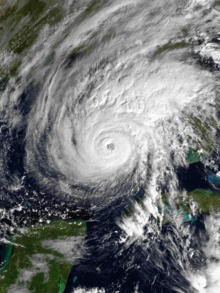 Hurricane Kate near peak intensity in the Gulf of Mexico on November 20 | |
| Meteorological history | |
|---|---|
| Formed | November 15, 1985 |
| Dissipated | November 23, 1985 |
| Category 3 major hurricane | |
| 1-minute sustained (SSHWS/NWS) | |
| Highest winds | 120 mph (195 km/h) |
| Lowest pressure | 953 mbar (hPa); 28.14 inHg |
| Overall effects | |
| Fatalities | 15 total |
| Damage | $700 million (1985 USD) |
| Areas affected | Haiti, The Bahamas, Cuba, Southeastern United States (Florida, Georgia) |
| IBTrACS | |
Part of the 1985 Atlantic hurricane season | |
Hurricane Kate was the final in a series of tropical cyclones to impact the United States during 1985. It was the eleventh named storm, seventh hurricane, and third major hurricane of the 1985 Atlantic hurricane season,[nb 1] Kate originated from the interaction of an upper-level trough and tropical wave northeast of Puerto Rico on November 15. Though the system tracked erratically during the first hours of its existence, the intensification of a region of high pressure to the cyclone's north caused Kate to turn westward. A favorable atmospheric pattern allowed the newly developed system to intensify to hurricane intensity on November 16, and further to Category 2 intensity three days later.
Kate made its first landfall on the northern coast of Cuba at this intensity prior to emerging as a slightly weaker storm during the evening hours of November 19. Once clear of land, it began to strengthen quickly, becoming a Category 3 and reaching its peak intensity of 120 mph (195 km/h) the following day.[2] On November 21, a cold front moving across the Mississippi Valley resulted in a north and eventual northeast turn of the cyclone, and on November 22, Kate came ashore near Mexico Beach, Florida, as a minimal Category 2 hurricane with winds of 100 mph (160 km/h). Gradual weakening ensued as the cyclone moved along the Southeast United States coastline, and Kate transitioned to an extratropical cyclone on November 23, a day after exiting the coastline of North Carolina. Kate was the most recent hurricane to make landfall in Florida during the month of November until Hurricane Nicole in 2022.
The threat of Hurricane Kate in Cuba prompted the evacuation of 360,000 people. Heavy rainfall in Cuba caused numerous mudslides and flooding, killing 10 people and leading to severe agriculture damage. Wind gusts over hurricane intensity resulted in widespread power outages, significant building damage, and major crop damage. Damage totaled roughly $400 million,[nb 2] making it the most damaging hurricane to strike the island in many decades. In preparation for the system's arrival, many hurricane watches and warnings were put into effect. Hundreds of thousands of residents were evacuated, and Florida governor Bob Graham declared a state of emergency for six counties; this was later cancelled following the relatively minor impacts of Kate. In addition, many shelters were opened.
When Kate struck the Florida Panhandle, it became the first hurricane to make landfall in that location since Hurricane Eloise in 1975. Storm surge and flooding rains destroyed much of the oyster industry, causing many people to lose their jobs in the weeks after the storm. Gusts over 100 mph (160 km/h) contributed to downed trees and building damage, while the combination of wind and rain led to downed power poles. Across the remainder of the southeast United States, several inches of rainfall led to flash flooding, damage to roadways, and major tree damage. Overall, Kate resulted in 15 fatalities and $700 million in damage.
- ^ Cite error: The named reference
glosswas invoked but never defined (see the help page). - ^ Robert A. Case (December 10, 1985). Hurricane Kate Preliminary Report (GIF) (Report). National Hurricane Center. p. 11. Retrieved November 17, 2016.
Cite error: There are <ref group=nb> tags on this page, but the references will not show without a {{reflist|group=nb}} template (see the help page).